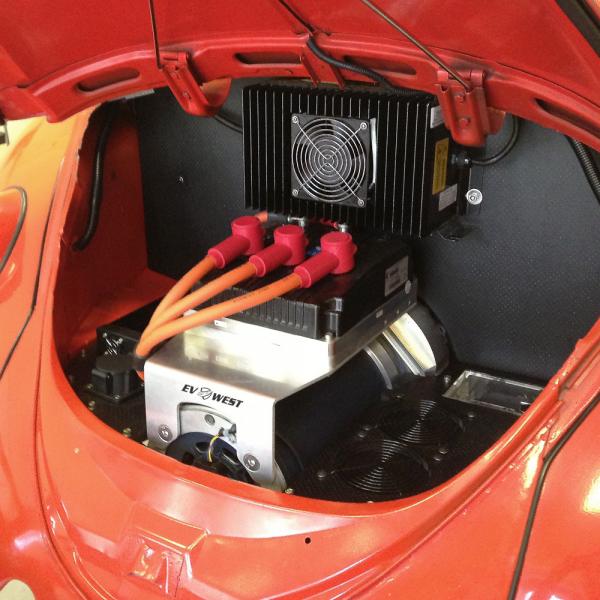
’63 VW Beetle EV Conversion
photo courtesy EV West
One attraction of driving an Electric vehicle (EV) is the instant power and torque they provide. But one commonality I noticed between all of the electric and hybrid vehicles I’ve driven is that NONE of them had manual transmissions. Is that because it’s:
1) not possible, 2) not practical, or 3) some other reason?
Electric vehicles can have a manual transmission, but most new production electric vehicles don’t use a manual transmission because it is not necessary, efficient or practical.
This article will take a closer look at why and how electric vehicles might have a manual transmission.
Electric vehicle motor and drivetrain design
New electric vehicles are designed with efficiency in mind and use induction motors that consist of two main parts, a stator and a rotor that is housed inside the stator. AC power is supplied to the stator which creates a rotating magnetic field. The induction motor is brushless and is capable of very high RPM compared to their internal combustion counterparts.
A great feature of induction motors is that the speed can be smoothly increased by changing the frequency of the AC power supply. The induction motor is connected to a gearbox, which transfers power from the motor to the wheels. A VFD (variable frequency drive) controls the motor speed, which in many motors can range from 0 – 18,000 RPM. I thought the redline of my (gone but never forgotten) E90 BMW M3 was impressive at 8,400 RPM, but it’s no comparison to the RPM range of an induction motor. Also, the torque curve on my beloved M3 would top out at around 400 Nm of torque at 3,900 RPM and required a transmission. A beautiful 6-speed manual transmission that I loved, but admittedly not as efficient as an electric induction motor with only one gear that never needs shifting.
By comparison, an electric induction motor can be more than 90% efficient and have consistent torque even as the RPM climbs. The rotational motion of the induction motor is also much more efficient than a traditional internal combustion engine that has to convert up and down motion of the pistons to circular motion to power the drivetrain.
Any benefit to having a manual transmission?
Not really, as much as I love a manual shift car, as mentioned before, the seemingly endless torque and smooth acceleration of an electric induction motor eliminate the need to change gears. With such a wide RPM range (0 – 18,000 RPM), there is no need to have multiple gears. It’s possible and preferable for an electric vehicle to go from zero to 120+ mph in one gear. And putting the car in reverse is as easy as reversing the power phase.
The induction motor setup is also very responsive. I remember the feeling when I first stepped (stomped) down on the accelerator of a Tesla Model S. I was going from an almost complete stop to a highway on-ramp with a 3-4% uphill grade. The car almost immediately reached highway speeds and I was an immediate EV convert. A professional race car driver could never change gears with a manual shifter or even paddle shifters as quickly and efficiently as the single-speed transmission of that Model S.
One pedal instead of three?
Actually, yeah. An electric vehicle could be driven with just one pedal. Because an EV uses regenerative braking, which uses the kinetic energy of the car to produce energy instead of using the brakes. This allows the driver to have a lot of control over the speed of the vehicle just using one pedal. For example, we had a Prius with more than 200,000 miles (321,869 km) and it never needed the brakes replaced. That’s mainly due to the regenerative braking feature. We did have to use the brakes, but much less than a car without regenerative braking. When you take your foot off the accelerator, the induction motor acts as a generator and charges the batteries while slowing the car.
Examples of EVs with manual transmissions
There are a few companies that convert traditional internal combustion engine cars to EVs, but one of the standouts is EV West. Located just north of San Diego in San Marcos, CA, they have been creating EV conversion magic for more than a decade. They offer several DIY kits for folks interested in converting their VW, Porche or other cars to electric power.
You can check out their YouTube Channel for some cool examples.
I love a manual transmission, and while it is possible to have a multi-speed transmission in an electric car, it would unnecessarily add weight, cost, complexity, and inefficiency. Aside from the classic car EV conversions, most production EV’s opt for a single-speed transmission because they are so efficient.
Final note: Sorry to end on a sad note for my fellow manual transmission fans, but a J.D. Power report from 2019 mentioned that electric vehicle sales in the US surpassed manual transmission car sales. 1.9% of vehicles sold in the US in 2019 were EVs and only 1.1% of all vehicles sold in the US had manual transmissions. Not even a 2021 Corvette offers a manual transmission….another topic for another website.

